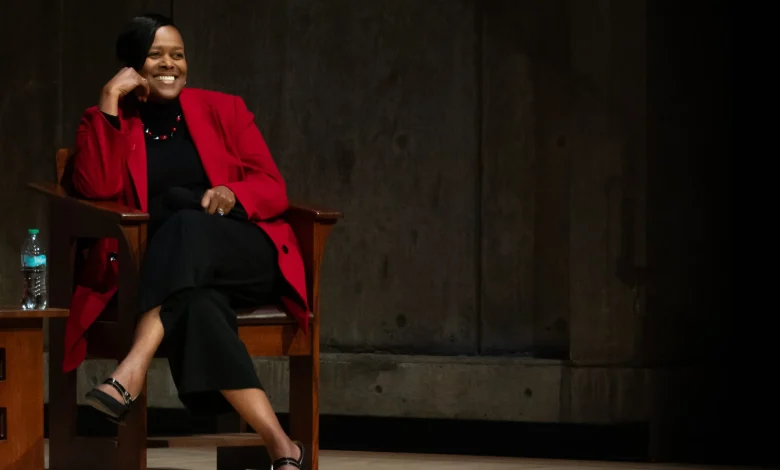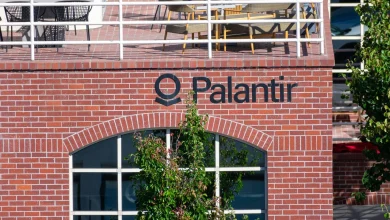Syracuse mayoral candidate Sharon Owens on I-81 viaduct removal, redevelopment of public housing

Deputy Mayor Sharon Owens is running to succeed Mayor Ben Walsh, whose administration she has worked in for the last seven years.
Owens is the Democratic candidate for mayor and faces Republican Tom Babilon independent candidate Timothy Rudd and independent candidate Alfonso Davis. If Owens wins, she will become the first Black woman to serve as mayor in the city’s history.
She has been a Syracuse resident since graduating from Syracuse University in 1985. She also serves as board president for Blueprint 15, the local nonprofit organization that is associated with community outreach for the billion-dollar East Adams redevelopment project.
Owens answered questions about the future of public housing redevelopment on the Southside as the New York State Department of Transportation brings down the Interstate 81 viaduct in phases. If she becomes the mayor of the city, Owens vowed to put pressure on the state to continue the conversation about what happens to the area landlocked by the bridge.
“We’re going to ensure that through that process, particularly removing the highway, that they [NYSDOT] are transparent. They’ve been great partners. I got to give NYSDOT its props [for] being transparent about the process, being transparent about the environmental necessities and components. And community advocates will not give them room to breathe, they’re going to continue to push that issue as they should,” Owens said. “The conversation yet to be had is what happens with that property once it’s not landlocked by a bridge.”
Editor’s note: The following interview has been edited for length and clarity.
Central Current: How would you have handled the East Adams public housing redevelopment project until now?
Sharon Owens: Some people believe that, you know, why raze it at all? Pioneer Homes is the original public housing in the entire nation. People who say, leave McKinney Manor alone, leave Pioneer Homes alone, clearly, you haven’t visited any of those units. They are antiquated and they are not 21st century housing.
So the idea and the master plan for that development is the right one: raze that housing and replace it with 21st century housing that is worthy of the individuals who live there. Here comes the complication. It is expensive. It is because it’s the housing authority and there are (U.S. Department of Housing and Urban Development) regulations, quite frankly, that I pray stay and are not really watered down by this [presidential] administration.
Let’s say they stay as they are. These regulations were the ones that were not present when the highway was built: relocations first, right to return. These are all critical protections for tenants. The thing that I’ve read is now HUD really taking a look at as they are for everything else, determining who is legal and who is not legal in this country and can be in that housing as we move forward, right. So, I am an absolute proponent of rebuilding the housing. There’s conversations about maybe even some of the Pioneer homes, buildings remaining for historic purposes, because it is the first public housing historically.
But overall, they’re old. The designs are old. It is that old model that HUD started to do away with a long time ago, and so I’m absolutely a proponent. The key is that we do it right, that the relocation gives people the opportunity, with the section eight voucher, to find another place to live, and then they have the right to return to this newly developed community. It’s going to be denser. So if you look at McKinney Manor now, it is going to be more apartments, so there’s going to be more people in that space, creating urban density.
So the first phase is Adams and State streets, kitty corner from the Civic Center, right. And then moving that construction also to do all four areas of McKinney Manor and then Pioneer Homes. They’ve explained to me, because I’m not a highway engineer at all, how you take down the highway. So, they’d say, pretty much, when you drive over the highway and you hear those rivets that you drive over. Those are basically puzzle pieces, and they will unhook those things and take them down one at a time. What the DOT has said is that they’re able to do that with people in place. I wouldn’t want to be in place while that was happening. So what will happen is the opportunity for the people closest to Almond Street to be able to move — because there are going to be more apartments — into these newly constructed properties. And the New York State Housing and Community Renewal has really said to the housing authority, and specifically, because they are the owner, we need you to prioritize that as you’re redeveloping McKinney Manor.
Central Current: As mayor, how will you move forward with the redevelopment project in the East Adams neighborhood?
Owens: I know we’ve heard this before, but this is the most optimistic I’ve been on the verge of closing to get this thing moving so we can start the demolition and start the redevelopment of these projects. As mayor, what we are doing right now is what I would be doing. So we’re at the phase of closing. Now we’re on phase three, four and five. What has to happen financially to get this moving? So we’re going to start looking at not only state funding, but what other public-private partnerships can we have?
Another concern of the people in the neighborhood is, of course, gentrification. The first right to return gives people who live there the opportunity to move back. Some people are going to take their voucher and buy a home, is what I hope they do, because section eight vouchers, unless that program is changed by the federal government, can also pay mortgages, and people don’t know this. So we’re in a parallel path of preparing people who live there for home ownership, because your voucher can pay your mortgage. We’ve been really thankful to be able to take a couple individuals so far from McKinney Manor, and you’ve seen that in the news, the governor came to town and they bought their first home on the South side of town.
Then there are other units that increase based on your income. So as there are people who work in the hospital or work for Centro or work other places in our city that live in the East Adams neighborhood, their rents increase to the amount that you can afford a house. And so that is what we’re really encouraging.
And just talking about my other hat for a minute as the board president of Blueprint 15, our faith program, and that is the housing home ownership preparation program for people who live in the East Adams neighborhood, people are signing up for that because I think people are realizing I can own a house, because you don’t know until you see somebody else, right? You don’t know what you don’t know, but you see somebody else actually go through the class, work on their credit, understand that this is actually a possibility for me. I know that 60% of home dwellers in this city are renters, and some people will always rent, but if you have an option to buy, that is the first step towards generational wealth.
Central Current: As mayor, what are some potential changes you might bring to the table with respect to redevelopment of public housing in the neighborhood?
Owens: So the responsibility and the requirements for redeveloping public housing again, if nothing changes on the federal end, is very scripted. It’s very specific to how you can develop, but it encourages you to partner with, you know, LIHTC funding and other funding sources that can diversify how you’re developing it. And I am a proponent of mixed income, not displacement, but mixed income, creating middle income opportunities for people. Quite frankly, it is very judgmental for people, or stereotypical for people who say, ‘Oh, everyone down there is the lowest of low income, everyone that lives in that neighborhood.’ That is not true. There are people who are middle income or lower middle income, who live in that neighborhood, who work in jobs in our community, probably two of them, that live in the neighborhood because the neighborhood’s home. So let’s create other options for them in that neighborhood. They want to stay in publicly subsidized housing? Great. If you don’t, my point is that you don’t have to move out of the neighborhood that your family grew up in, your mother and your mother’s mother grew up in. That’s what I want to ensure, is that the diversity of the housing in that neighborhood lends to anyone who lives there don’t feel that they don’t have to leave there, whether it’s public housing, low income tax credit housing, or you buy market rent somewhere in that neighborhood.
Central Current: With regard to the I-81 Viaduct Project, how will you, as mayor, ensure the protection of residents’ healths, during and especially after the construction?
Owens: So the ACLU and Lead Safe CNY and other entities, they have been engaged probably for close to two years now, with SUNY Upstate and the DOT for air quality monitoring. I remember the last community meeting we had was at the Dunbar Center where we talked about what the air monitoring will be, what the sticky mats and the cautionary things that will happen for residents who choose to stay there.
The viaduct is scheduled to come down in 2027. So I will have been in office a year to ensure all of that process is still going on, to ensure that the DOT continues to update us on what actually will happen when that highway [comes down], what are the components of that highway coming down.
What people are not aware of and what I learned is that they’re actually going to redevelop Almond Street first. So I thought that was kind of backwards. But they said no, Almond Street will be redeveloped first and then they will take the highway down. To me, it was like refinishing your floor, and then taking your roof down. It seemed different to me. It seemed backwards, but I’m not a civic engineer, so that’s what they said they’re going to do. So continuing to work with that environmental group. They had a really solid group, led by the ACLU with Upstate and the DOT to really ensure air quality, monitor and inform, and provide supplies to tenants and homeowners. Remember, there are homeowners just south of the East Adams footprint. … Again, remembering that while we’re redeveloping McKinney Manor, move as many people that want to come away from the viaduct or Almond Street as possible, away from Almond Street.
Central Current: What are some other issues you would press NYSDOT on?
Owens: When that highway comes down, I’m just gonna go down there and put on my sneakers and stand and look. I’ve never seen Syracuse without that highway. So I want to soak it all in, right?
But one huge component of that is all of the land under it. So most people don’t experience this because they don’t walk Almond Street, it’s not a real walkable Street. But all that parking under there, all of the fence and parking along the street south to north, that’s all owned by New York State. What we said during the DEIS process was we need to pull together a group of individuals who will begin to talk about the conveyance of that property over to the city of Syracuse. That property needs to come to the city of Syracuse. If New York state owns it, New York State will do with it what New York State does with it, and we don’t know what that would be. But if the city owned it, there would be a very locally public process, because it would have to be zoned accordingly. So we can have conversations about what the zoning could be there, what the use would be there, but it would be a public process, because all of that land that is not owned by the city now would become city-owned land that we would have to go through a public process, just like we did for a rezone to really determine the use of that property.
What I’ve been told is that because it’s a federal highway project, the Federal Highway Administration, which also makes me nervous again, will weigh in to what the possible uses could be. So one thing, when talking with our partners, ACLU and some other folks, I was like, before we go at each other about like the ACLU has wanted land set aside, almost like a land bank, you know, that whole process, which I’m supportive of, part of it, I’m supportive of that for the community, have some control over what is developed, right? But what I’ve said is that we’re kind of going back and forth for each other to make a decision about that, and New York state hasn’t said what the use of it can be.
New York State could come back and say it can only be used as green space. So would we have a Central Park in that area, Syracuse-equivalent to Central Park in that area? Would that be a bad thing? Not necessarily, you know. But what New York State has been saying to us is that we want to wait till the construction is over. We don’t want to wait till the construction is over.
So as mayor, I will continue to put the pressure on New York State: we need you to start the process for establishing the use of that property. While all of the construction is happening, the conversation not happening is what is going to happen with all of that land that will no longer be landlocked by a bridge, and that is a critical element of this project.
Read more of Central Current’s coverage
Syracuse mayoral candidate Tom Babilon on I-81 viaduct removal, redevelopment of public housing
Tom Babilon, the Republican candidate for mayor, talks the removal of the I-81 viaduct and the redevelopment of public housing.
Syracuse mayoral candidate Sharon Owens on I-81 viaduct removal, redevelopment of public housing
Sharon Owens, the Democratic candidate for mayor, talks the removal of the I-81 viaduct and the redevelopment of public housing.
Syracuse mayoral candidate Tim Rudd on I-81 viaduct removal, redevelopment of public housing
Tim Rudd, an independent candidate for mayor, talks the removal of the I-81 viaduct and the redevelopment of public housing.
Syracuse mayoral candidate Alfonso Davis on I-81 viaduct removal, redevelopment of public housing
Alfonso Davis, an independent candidate for mayor, talks the removal of the I-81 viaduct and the redevelopment of public housing.
2025 election Q&A: Onondaga County Legislature 3rd District candidate Tim Burtis
Tim Burtis, the chairperson of the Onondaga County Legislature, is running unopposed to retain his seat.





